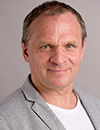Co-Located Conference AgendasBioengineering for Building Microphysiological Systems 2022 | Extracellular Vesicles & Nanoparticle Therapeutics Europe 2022 | 

Monday, 24 October 202208:00 | Conference Registration, Materials Pick-Up, Morning Coffee and Tea | |
Session Title: Conference Opening Session -- Bioengineering to Build MPS 2022 |
| | 09:00 |  | Conference Chair Building a Human Body on a Chip: An Ongoing Journey 1989-20?? — A 33-year Odyssey
Michael Shuler, Samuel B. Eckert Professor of Engineering, Cornell University, President Hesperos, Inc., United States of America
A physiologically representative, multiorgan microphysiological system (or MPS) based on human tissues may become a transformative technology to improve selection of drug candidates most likely to earn regulatory approval from clinical trials. Also, such systems can be used to test cosmetics, food ingredients, and chemicals for potential toxicity. In this talk we will explore the history of the development one type of MPS known as a "Body-on-a-Chip" as well as current and future elaborations of this technology. Current "Body-on-a-Chip" systems combine organized tissue/organ mimics with the techniques of microfabrication based on PBPK (Physiologically Based Pharmacokinetic) models. Currently these systems are "self-contained" and do require external pumps, leading to "pumpless systems" which eliminates the need for an external pump, reduces system cost and improves operational reliability. While the fluid (or blood surrogate) in these systems can be sampled directly to allow measurement of concentrations of drug, metabolites or biomarkers, they can also be interrogated in situ to determine functional responses such as electrical response, force generation, or barrier integrity. The blood surrogate can be made to be as a serum-free, chemically defined medium facilitating interpretations of responses that are more mechanistic than with serum containing media. A key advantage of this approach is that we can predict both human efficacy and toxicity of a drug or drug combination in preclinical trails, A Hesperos system has been used as the sole source of efficacy data for an IND application by Sanofi for a drug currently in a Phase 2 clinical trial and data from an Emulate system has also been used to support an IND. For these systems to fulfill their real potential in drug development such use of these systems must become routine. Further there are questions on human toxicity of cosmetics and other chemicals, particularly mixtures, that can be addressed with such systems. |
| 09:45 |  | Conference Chair Nervous System-on-a-Chip: Closing the Knowledge Gap Between in vitro and in vivo Experiments
Regina Luttge, Professor, Eindhoven University of Technology, Netherlands
Many advances in in vitro technologies to study brain cell cultures have been made by means of microfluidic Brain-on-a-Chips. However, the development of Brain-on-Chips primarily focus on the implementation of cortical cells from human stem cell source in a 3D cultured microenvironment. Instead, the objective of our EU project CONNECT is to mimic the in vivo functions of the nervous system in one connected chip system. Hence, the project brings together the knowledge accumulated among neuroscientists, stem cell experts and engineers to investigate the origins and possible treatments for Parkinson's disease in an extension of the brain-on-chip model, called nervous system-on-chip, linking tissue of the central nervous system and the enteric nervous system. In this presentation, we discuss the importance of instructive micromechanical cues next to the complexity of culture conditions in nervous system on a chip that can be simplified by selecting scaffolding materials containing instructive physical cues by design rather than ill-defined and poorly controllable biological matrices. Finally, we pinpoint on the importance to correlate findings in vitro with observations to be correlated with results from in vivo modeling. |
| 10:30 | Morning Coffee and Tea Break and Networking | 11:15 |  | Keynote Presentation Microphysiological Systems – Why is Industry Adopting Slowly?
Marian Raschke, Head of Advanced Cellular Models, Bayer AG, Pharmaceuticals Division, Germany
Advanced cellular models and microphysiological systems (MPS) have the potential to fundamentally change the test and assessment strategies in pharma industry’s R&D which for decades relied to a great extent on animal experimentation complemented with rather simple in vitro assays. This has led the so-called “valley of death”, an evident translational gap between preclinical and clinical observations related to both safety and efficacy assessments, which ranks among the leading causes of drug failure. The ongoing transformation of the pharma industry, moving from small molecule drugs to highly diverse therapeutic modalities, including cell and gene therapy, together with increasing public and regulatory expectations for alternatives to animal testing, provides a fertile ground for MPS and other advanced cellular models. The talk will provide a general introduction of the past, present, and anticipated future role of in vitro testing in the pharma industry with focus on the application of MPS in the field of safety testing. This will be complemented by a pharma end-user perspective on opportunities and current limitations hindering a more widespread use of MPS. Moreover, recent in-house use-cases involving MPS in Investigational Toxicology will be shared to contextualize the outlined perspective. |
| 12:00 | A Human Kidney and Liver Organoid-based Organ-on-a-chip Model to Study the Therapeutic Effects and Biodistribution of Mesenchymal Stromal Cell-derived Extracellular Vesicles
Bas WM van Balkom, Assistant Professor, University Medical Center Utrecht, Netherlands
Mesenchymal stromal cell (MSC)-derived small EVs (sEVs) show therapeutic potential in multiple disease models, including kidney injury. Clinical translation of sEVs requires further preclinical and regulatory developments, like elucidation of the mode of action (MoA) and formulation of safety and release criteria. sEVs tend to accumulate in the liver and at sites of injury. Biodistribution knowledge is crucial to assess MoA, efficacy and safety, and can be obtained using labelled sEVs in animal models, which come with ethical concerns, are time-consuming and expensive, and do not represent all human physiological processes equally well. We developed an organoid-based organ-on-a-chip model to assess the efficacy and biodistribution of these sEVs. The human background allows for in-depth analysis of the MoA and identification of potential side effects and accelerated development of EV-based therapeutics. | 12:30 | Networking Lunch in the Exhibit Hall -- Meet Exhibitors and Engage Over Lunch | 14:00 |  | Keynote Presentation Human on a Chip Systems Applied to Neurodegenerative and Rare Diseases
James Hickman, Professor, Nanoscience Technology, Chemistry, Biomolecular Science and Electrical Engineering, University of Central Florida; Chief Scientist, Hesperos, United States of America
We have been constructing multi-organ human-on-a-chip systems for toxicology and efficacy with up to 6 organs and have demonstrated long-term (>28 days) evaluation of drugs and compounds, that have shown similar response to results seen from clinical data or reports in the literature. Application of these systems for neurodegenerative and rare diseases such as ALS, Alzheimer’s, CIDP, MMN, Myasthenia gravis, as well as its application to opioid overdose and recovery will be described. These models utilize a pumpless platform with serum free recirculating medium, which is a low volume system that can evaluate parent compounds as well as metabolites, if the liver is included. Our research focus is on the establishment of functional in vitro systems to address phenotypic deficits to create organs and subsystems to model motor control, muscle function, myelination and cognitive function, as well as the potential for including cardiac, BBB, kidney, GI tract and liver subsystems. Acute and chronic compound testing in systems for concurrent measurement of both efficacy and toxicity has also been done in the same system for therapeutic index estimation. A specific embodiment of this technology is the creation of a functional human NMJ system to understand ALS where we have investigated the four primary mutations found in ALS patients; SOD1, FUS, TDP43 and C9ORF72 and demonstrated variations of the disease phenotype as well as response to therapeutics. We also will describe an Alzheimer’s disease model based on long-term potentiation, a correlate for learning and memory, which has reproduced aspects of amyloidopathy and tauopathy, and shown drug selective reversal with current AD therapeutics. Sanofi has used efficacy data from one of our models to file an IND that has enabled a clinical trial (#NCT04658472) and is described in our recent joint publication (Rumsey et al. 2022). We will also describe a multi-organ innate immune system that was able to reproduce the pro-inflammatory and restorative phenotypes from macrophages. |
| 14:30 | Human Adherent Cortical Brain Organoids in a Multiwell Format
Femke de Vrij, Associate Professor, Erasmus Medical Center, Netherlands
Recent developments in induced pluripotent stem cell technology offer the unique opportunity to implement lineage-specific human cellular models suitable for drug development applications. Here, we expand on our platform for adherent cortical organoids that resemble the human frontal cortex during early development. The resulting 3D MICro-brains model the essence of cortical structure formation in a miniature format that is literally about 1-millionth the size of a normal human brain. The platform contains all relevant brain cell types: functional neurons and glial cell types in layered radial structures, including astrocytes, myelinating oligodendrocytes and microglia. This advanced 3D MICro-brain platform is amenable to high-throughput analyses for toxicity testing and screening purposes aimed at discovery of pathophysiological mechanisms and therapeutic compound testing for neurodevelopmental and psychiatric disorders. | 15:00 | High Throughput Phenotypic Screening with Organ on a Chip
Henriëtte Lanz, Director, Model Development, MIMETAS BV, Netherlands
Organ-on-a-Chip is a powerful technology driving physiological relevance by utilizing microfluidic techniques. The technology is expected to impact drug development and ultimately replace or reduce animal testing. Since most platform technologies are either based on single chips or small numbers of chips in dedicated surroundings, application for Organ-on-a-chip is largely envisioned in pre-clinical testing, such as preclinical safety, pharmacology, or pharmacokinetics. Thus far it was thought that with the advanced complexity of models prevents use in drug discovery studies. The OrganoPlate is an exception to this rule, as it comprises 40 to 96 chips. The microtiter plate footprint renders it fully compatible with automated imaging and robotic handling. In fact, Kane et al. reported automation of the platform for long term maintenance of dopaminergic neurons in a Parkinson’s Disease study. High throughput screening applications utilizing Organ-on-a-Chip technology, however have thus far not been reported. Here we report a 1500+ compound screen on a 3D angiogenic sprouting assay. We utilized a newly developed platform, the OrganoPlate 3-lane 64, which comprises 64 chips underneath a microtiter plate. Similar to other versions of the OrganoPlate platform, it utilizes surface tension techniques to stratify extracellular matrix gels and tissue layers and employs passive leveling between reservoirs for inducing flow. Each chip comprises a gel lane and is flanked by two perfusion lanes. Human Umbilical Vein Endothelial Cell (HUVEC) microvessels were grown against a collagen gel according to previously reported protocols. The effect of a small molecule protein kinase inhibitor library of over 1500 compounds was assessed on the angiogenic sprouting behavior of the vessels. The microvessels were exposed to an optimized cocktail of angiogenic factors in conjunction with the compound utilizing automated liquid handling. Readouts including sprout length, sprout and microvessel morphological changes were used. Cultures were imaged using a high content device (Molecular Devices, ImageXpress Micro Confocal). The screen yielded a limited number of hits that either enhanced or inhibited angiogenic capacity. The OrganoPlate 3-lane 64 showed considerable benefit over its predecessor, the OrganoPlate 3-lane 40, not only due to the increased density of chips, but also its 8-well pipette pitch for functionally similar inlets and outlets. This is the first time that Organ-on-a-Chip is reported to be utilized in a large library screen, opening up the route towards early drug screening on tissue models of unrivaled physiological relevance. | 15:30 | Mid-Afternoon Coffee and Tea Break | 16:00 | Development of Pumpless Single-Organ and Multi-Organ Microphysiological Devices
Mandy Esch, Project Leader, National Institute of Standards and Technology (NIST), United States of America
We developed several pumpless microphysiological cell culture systems that can be used to co-culture interconnected human tissues with near-physiological amounts of recirculating blood surrogate (cell culture medium). Our GI-tract – liver system can simulate the oral uptake and first pass metabolism of drugs, and our two-organ and four-organ systems can be used to detect primary and secondary drug toxicities. Short channel connections and pumpless operation using gravity enabled us to reduce the amount of liquid needed to operate the systems. We demonstrate the systems with tissues scaled at 1/73,000 and cultured under drug exposure for 24 h. Our approach allows us to reduce the dilution of recirculating drug metabolites that cause acute toxicity. Better predictions of drug toxicity and efficacy with in vitro systems are needed, since clinical trials with humans often do not reproduce the results seen with animal models. | 16:30 |  | Keynote Presentation Design, Prototyping and Feasibility Studies for Pump-based Multi-Organ MPS
Uwe Marx, CSO & Founder, TissUse GmbH, Honorary Professor for Medical Biotechnology at the Technische Universität Berlin, Germany, Germany
Microfluidic microphysiological systems have proven to be a powerful tool for recreating human tissue- and organ-like functions at research level. This provides the basis for the establishment of qualified preclinical assays with improved predictive power. However, industrial adoption of MPS-based assays is progressing slowly due to their complexity. The presentation focusses on the design and prototyping principles of the microfluidic HUMIMIC® platform integrating on-chip micro-pumps and capable to maintain functional various human organ model combinations or single organ equivalents over weeks. Challenges of industrial adoption of the platform, with the focus on models supporting repeated dose testing will be discussed. The creation of complex physiology-based autologous multi-organ systems, mimicking adsorption, distribution, metabolism, excretion and crucial organismal feedback loops will be pointed out. Feasibility study data will be presented. |
| 17:00 |  | Keynote Presentation Organ-Chips: New Applications, Predictive Validity and Economic Implications
Daniel Levner, Chief Technology Officer, Emulate, Inc., United States of America
Organ-on-a-Chip technology continues to evolve both in the breadth of the applications that it addresses, as well as in the depth of its qualification data and understanding of its contexts of use. In this presentation, we review recent work on modeling immune-cell recruitment for applications in the study of inflammation and immune-oncology. In addition, we discuss the qualification of the Emulate Liver-Chip using a framework defined by the Innovation and Quality (IQ) consortium, as well as an evaluation of its predictive value against known clinical outcomes using a blinded set of 27 hepatotoxic and non-toxic drugs. We conclude by exploring the potential financial impact that could result from the adoption of the Emulate Liver-Chip in the small-molecule pharmaceutical industry and estimate that the level of accuracy displayed in this study could generate $3 billion annually due to increased R&D productivity. |
| 17:30 | Networking Reception with Dutch Beer Sponsored by Emulate: Engage and Network with Colleagues | 18:30 | Close of Day 1 of the Conference |
Tuesday, 25 October 202208:00 | Morning Coffee, Tea and Networking in the Exhibit Hall | 09:00 | Design of an Enzyme-free Microfluidic Electrochemical Biosensor for Lactate Detection Using NiO-NPs
Rohollah Nasiri, Postdoctoral Researcher, KTH Royal Institute of University Stockholm, Sweden
Detection and monitoring of the lactate in human body fluids and in vitro cell culture systems is crucial for studying metabolic disorders. Enzymatic lactate sensors suffer from low stability, poor reproducibility, and high cost. Non-enzymatic sensors take advantage of nanostructured-based electrodes by providing large surface area and high electrocatalytic efficiency which offer high stability, reproducibility, and without immobilization procedure. In this work, we designed an enzyme-free microfluidic electrochemical lactate sensor using screen printed electrodes. First, the working electrode was modified by drop-casting of NiO/Nafion dispersion and later the sensor performance was analyzed using cyclic voltammetry (CV) and amperometry. The CV showed an optimal working voltage of ~0.5V. Using amperometry the current response of the sensor for different concentrations of lactate at ~0.5V was determined. Results showed a linear calibration curve between the concentration of lactate and generated current. Later, we designed a microfluidic platform consisting of a micromixer to mix the cell culture media sample with electrolyte solution and integrated it to NiO-based lactate sensor to have a flow-through biosensor. We used the proposed sensor for lactate detection in the cell media for ketogenic diet-treated astrocytes and it showed good sensitivity, selectivity and being insensitive to common interferents. The proposed microfluidic lactate sensor is well-suited to be connected to organ-on-a-chip platforms for metabolic studies.
| 09:30 | Building Complex Neuronal Networks on Chips to Understand Neurodevelopmental Disorders
Nael Nadif Kasri, Professor Medical Neurosciences for Neurodevelopmental Disorders, Radboud University Medical Center Nijmegen, Netherlands
Recent progress in human genetics has led to the identification of hundreds of genes associated with neurodevelopmental disorders (NDDs). Despite considerable progress in elucidating the genetic architecture of NDDs, a major gap exists between the genetic findings and deciphering the pathophysiology of NDDs. Induced pluripotent stem cell technology allow us to generate all cell types present in the brain, in vitro, in a patient-specific manner. However, for most NDDs we currently do no know the exact cellular loci of disease, i.e. which cell type is contributing to the pathophysiology. In this talk I will explain our strategy to disentangle the cell type-specific contribution to neuronal network phenotypes in the context of NDDs. We generate composite cultures consisting of well-defined cell types differentiated on micro-electrode arrays (MEA) to probe for neuronal network activity during development. In addition, we combine MEA recordings with transcriptomics within the same experiment (MEA-Seq) to identify molecular pathways that underlie specific neuronal network phenotypes observed in ASD subtypes. Our data indicate that MEA-Seq is a robust and sensitive method to perform genotype-phenotype analyses, which can serve as a powerful platform to identify functional points of convergence between NDD genes and be used for high-throughput drug screening assays. | 10:00 | 3D VESSELS-ON-CHIP TO MODEL VASCULAR DISEASE AND BEYOND
Valeria Orlova, , Leiden University Medical Center, Netherlands
Small vessel diseases are the leading cause of disability and death worldwide. The major challenge is that they are multisystem disorders affecting different organs, such as the brain, heart and kidney. They have been difficult to model in vitro because high-quality vascular cells are difficult to derive from patients and the local organ microenvironment which is difficult to mimic often contributes to the disease. For this reason, human induced pluripotent stem cells (hiPSCs) have become attractive sources of patient- and organ-specific cells. We use hiPSCs to re-create blood vessels on microfluidic chips that recapitulate micro- and macrovascular networks and the local microenvironment. We developed efficient protocols to differentiate hiPSCs towards ECs, pericytes/vSMCs, and inflammatory cells (monocytes and pro- and anti-inflammatory macrophages). We have demonstrated that both micro- (10-50 µm) and macro-scale (250-300 µm) perfusable 3D vessels composed of hiPSC-derived endothelial cells, pericytes/vSMCs, and other non-vascular components, such as hiPSC- derived astrocytes, can be generated inside the microfluidic devices. Recently we also developed a microphysiological system that behaves as a human “mini-heart” using cardiomyocytes, endothelial cells, and cardiac fibroblasts all derived from hiPSCs. These mini-hearts can be produced just 5000 cells and without specialized equipment. They thus represent a low-cost, low tech platform for cardiac drug discovery and disease modeling. Using isogenic patient hiPSC lines and 3D vessels-on-chip, we recapitulated the phenotype of a genetic vascular disease called hereditary hemorrhagic telangiectasia (HHT). This patient-based hiPSC model serves as proof of principle that vascular diseases can be modeled using patient-specific hiPSCs in 3D microfluidic chips and used to identify new target cells and possible pathways for therapy. | 10:30 | Mid-Morning Coffee, Tea and Networking in the Exhibit Hall | 11:00 | Combinatorial Drug Screening on 3D Ewing Sarcoma Spheroids Using Droplet-based Microfluidics
Raphael Tomasi, Cofounder & CTO, Okomera, France
At Okomera, we develop a unique technology for miniaturized, automated
and functional cell assays in precision cancer medicine. Our droplet
microfluidic workflow enables to encapsulate patient cancer cells from a
biopsy, and quickly form a single 3D microtumor per droplet. This
versatile microfluidic toolbox enables sequential 3D co-culture,
hydrogel encapsulation, fluorescent assays or multiplexing to up to 100
conditions per chip. Okomera provides a laboratory instrument,
microfluidic consumables and an Artificial Intelligence-powered analysis
software to extract quantitative features from microscopy images of the
chip and assess drug efficacy ex vivo.
Here, we applied concomitant and sequential drug combination of two
chemotherapies, etoposide and cisplatin to the Ewing sarcoma cell line
A673. Microtumors were formed in 500 nL droplets and then fused with
secondary droplets containing fluorescent-barcoded drugs at different
concentrations. Differences in microtumor growth and viability were
analyzed on around 300 microtumors per experiment. This enabled accurate
estimation of IC50 values for each drug, in agreement with measurements
obtained in standard non adherent multiwell plates. Using this
straightforward method, synergistic drug combination was found when both
drugs were tested simultaneously or sequentially. Interestingly,
sequential combination treatment with etoposide applied 24 h before
cisplatin resulted in an amplified synergistic effect.
| 11:30 | Advanced Disease Modeling Utilizing Human Stem Cell-derived Cells
Verena Schwach, Assistant Professor, Applied Stem Cell Technologies, University of Twente, Netherlands
Cardiovascular diseases are one of the major causes of mortality and morbidity worldwide. However, current disease models are often not predictive enough because of species differences or lacking complexity. It is of major importance to create models able to predict the effect and toxicity of novel drugs and understand underlying disease models. We differentiate human pluripotent stem cells towards a variety of cells, which provides us with an unlimited source of human cells for 3D tissue engineering and disease modeling. Together with state-of-the-art CRISPR/Cas genome editing, we also generate in vitro models inherited disease. | 12:00 |  | Keynote Presentation Emulating Organ-Organ Interaction Using Scalable Microfluidics and Multi-Cellular Spheroids
Olivier Frey, Vice President Technologies and Platforms, InSphero AG, Switzerland
Over the past years, we have developed the different technical and biological components ultimately merging into a scalable microfluidic multi-organ platform applicable for a broad spectrum of pre-clinical studies. An example we are currently advancing is a microphysiological 3D human liver – islet microtissue platform, that enables direct liver – pancreas crosstalk and a better understanding of metabolic diseases. We use 3D spheroids as biological organ models. They have become one of the most frequently used 3D cell culture systems in research and pharmaceutical industry, mainly due to their reasonable balance between physiological relevance and experimental complexity. The liver model consists of a primary Hepatocyte – Kupffer – Stellate cell triple-culture with preserved metabolic and inflammatory function over at least four weeks. Islet microtissues comprise all endocrine cells at physiological ratio and remain glucose responsive over the same duration. Both models are combined in microfluidic culturing device enabling interconnecting of up to ten 3D spherical microtissues. The microfluidic platform meets the requirements for scalability through the use of an injection-molding mass-fabrication process and a gravity-driven tubeless flow concept, which enables parallelization. Large-scale multi-tissue experiments are enabled with a fast and reliable method for loading of quality-controlled spheroids using a fully automated robotic pick-and place-transfer. |
| 12:30 | Engineering Inspired Biology: Cells as a System Component in a Microphysiological System
Berend van Meer, Chief Technology Officer, DEMCON Biovitronix and Researcher at LUMC, Netherlands
Organs-on-Chips and microphysiological systems (MPS) are highly complex devices to develop, not least because they require integration of many different modalities (e.g. material science, engineering, biology). Inherently, cell culture is highly variable and the solution to cope with this is typically to keep environmental features exactly the same since it is often unknown to what extend they are affecting the cell culture. This results in a requirement for highly reproducible devices to test biology, something which is difficult to realize for complex systems such as MPS – especially in research phases. While in this field engineering is mostly used to mimic physiological environments, we could aim to use engineering as a way to actively overcome the variability of biological components. Not by making just a reproducible static environment, but an adaptive environment. | 13:00 | Networking Lunch | 14:00 | Round Table Discussion Focusing on Microphysiological Systems: Technology Trends and Adoption by the Pharma Industry -- Chaired by Professor Mike Shuler and Professor Regina Luttge
|
|


 Add to Calendar ▼2022-10-24 00:00:002022-10-25 00:00:00Europe/LondonBioengineering for Building Microphysiological Systems 2022Bioengineering for Building Microphysiological Systems 2022 in Rotterdam, The NetherlandsRotterdam, The NetherlandsSELECTBIOenquiries@selectbiosciences.com
Add to Calendar ▼2022-10-24 00:00:002022-10-25 00:00:00Europe/LondonBioengineering for Building Microphysiological Systems 2022Bioengineering for Building Microphysiological Systems 2022 in Rotterdam, The NetherlandsRotterdam, The NetherlandsSELECTBIOenquiries@selectbiosciences.com